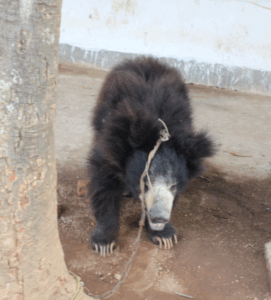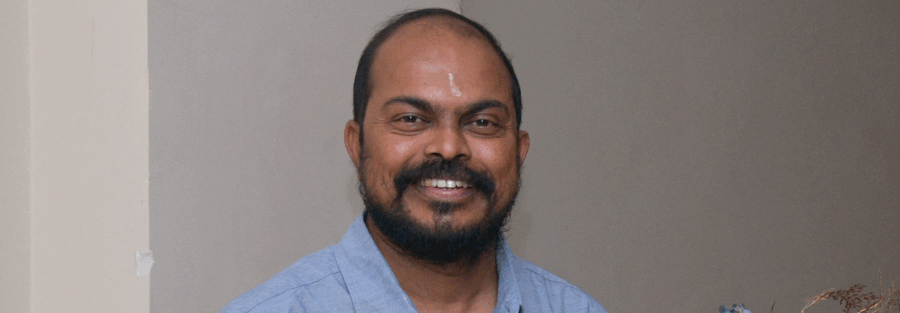For centuries, sloth bears were forced to “dance” on the streets of India, a practice rooted in exploitation and poverty. That cruel tradition is now history. In this conversation, Baiju Raj M.V., Director of Conservation Projects at Wildlife SOS, reflects on the long struggle to end it.
Q: You were part of the project that helped end the centuries-old tradition of dancing bears in India. Can you take us back to the early days—what did a typical rescue mission involve?
Baiju Raj M.V.: When I joined Wildlife SOS, my task was to rescue dancing bears. We would travel to different states, meet the Chief Wildlife Warden, and explain that we wanted to microchip the bears so they could be surrendered voluntarily to the Forest Department and then brought to our center in Agra.
The trade involved three groups: the poacher, the middleman, and the Kalandar community, who used the bears for street performances. These animals often lived only six or seven years before dying, and then another cub would be taken from the wild. I saw this trade firsthand in Jharkhand, Bihar, and eastern Uttar Pradesh. These were remote villages, suspicious of outsiders. But slowly, we were able to convince people to surrender their bears.
The first bear was rescued in 2002. By 2009, I had personally rescued more than 200 bears, transporting them to facilities in Agra, Karnataka, and Madhya Pradesh.
Q: What kind of physical and emotional condition were the bears in when you first encountered them?
Baiju Raj M.V.: It was very sad. Their noses were bleeding, with ropes forced through and tied around their necks. The handler would hit them with sticks connected to those ropes. Sometimes, we would microchip a bear and plan to return a week later for the rescue, only to find it dead.
They were also fed burnt rotis, which caused cancer. Tuberculosis and leptospirosis were common. Many had broken teeth or missing canines. Some were blind. Their condition was filthy, and it was painful to witness.
Q: Is there a particular rescue story that has stayed with you?
Baiju Raj M.V.: There are many. Once in Jharkhand, we kept a rescued bear in a hotel cage because the handler had vanished after receiving his remuneration. The bear broke free inside the hotel. The owner was kind enough to let us manage until we could secure it again. That man is still in touch with me today.
In those days, it was pure passion and madness that drove us. There was no social media, no showing off—only the work of rescuing animals.
Q: Wildlife SOS also worked with the Kalandar community, who depended on this practice for their livelihood. What was the hardest part of that process?
Baiju Raj M.V.: The Kalandars lived in deep poverty. Their children had no proper clothes, they stayed in huts covered with tarpaulin, flooded during rains. It was painful to see.
We supported them by providing sheets for shelter, uniforms, and school fees for their children. I remember once a teacher refused to admit Kalandar children because they were dirty. We bought uniforms, paid their fees, and soon the principal was calling us every month with updates. With Wildlife SOS funding, many children from these families began studying. That change gives us pride.
Q: What did healing look like for the bears once they arrived at the sanctuary? How long did it take before they started behaving like wild animals again—if ever?
Baiju Raj M.V.: Every wild animal has instincts, but these bears lost much when they were taken as cubs. They never had their mother’s care. Some became friendly over time, while others remained aggressive.
I believe aggressiveness is directly proportional to the torture they endured. Some had multiple nose piercings from repeated ropes. Even when we cut the rope, they were scared, because for them a cut rope meant a new wound. Many were blind or toothless. Some recovered, but not all.
Q: India is now officially free of dancing bears. From where you stand, what did it take to make that happen—and what does it mean to you personally?
Baiju Raj M.V.: This was possible only because of collaboration. The Forest Department, Police, and Judiciary all played crucial roles. Earlier, when courts confiscated bears, there was nowhere to send them. Sometimes handlers even received court orders to keep them. With Wildlife SOS centers, authorities finally had a place to send rescued bears.
Between 2005 and 2009, we rescued 628 bears. If this had not happened, hundreds of cubs would still be poached every year. The sloth bear might have gone from vulnerable to critically endangered. Today, that has been stopped.
Personally, I am proud that our co-founders, Geeta Seshamani and Kartick Satyanarayan, took the initiative. If nobody had started this, the bears would still be on the streets of India.



